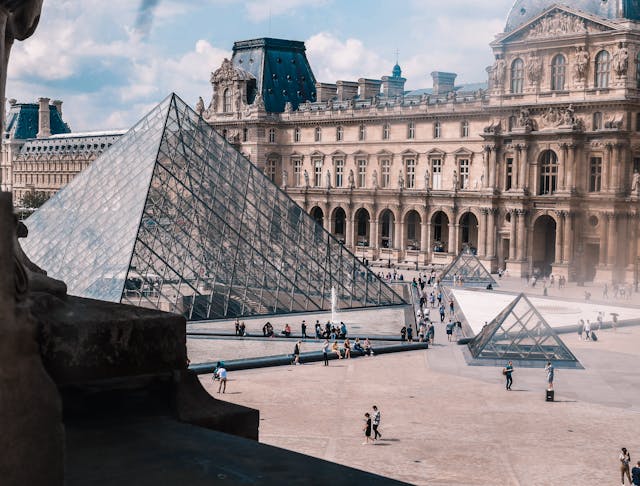
Why did the Louvre become a museum and art gallery? It was decided that the Louvre Palace should become an art gallery during the French Revolution.
There is some argument as to why the Louvre is called the Louvre. There are four competing theories. It could be because the Louvre was built on an area of forest that was full of wolves, and the Latin for wolf is lupus, which because louvre. It could be because the fort was built on the site of a monastery that had been called Luvra. It could be because watchtower is lower in the language of the people that used to live in Northern Gaul. It could be because the structure of the early Louvre was nicknamed “the work” by the people who lived around it and in French that is “ouvrer”. There is no way of knowing.
The Louvre started out life in 1190 as a fortress to protect the city of Paris from the English. England controlled Normandy, which is in the north west of France and about 20 km from the western edge of Paris. England controlled Normandy because William the Conqueror, who invaded and became King of England in 1066, was also the Duke of Normandy. The French king, King Philip II, built a wall around Paris and he built forts at various points to defend the wall. The Louvre was a fort built on the western corner, by the Seine, on the road to Normandy. The fort was square and had a moat around it. The main problem with city walls is that the city expands and people are forced to build on the outside of the city wall. Most major cities have built several different city walls, and Paris is no different. There have been seven different city walls altogether. The first was the Roman wall and Philip’s was the second. After the third wall was built in the 1350s, the Louvre found itself inside the city.
The Louvre had been built as a fortress, but by the late 14th century it had no purpose because it was inside the city walls. King Charles V decided to make it into a royal residence. He had adjustments made to the building but kept the main structure largely intact, but he had a lot added to it. He added towers, walls, more moats, and extra wings. It became something of a palace. Following kings lived in the Louvre as well, but by the end of the 15th century, they had other, better palaces and they started to live there instead. By 1527, no one was living in the Louvre and it was falling apart.
When Francis I became king in 1515, he started looking for a new palace in a more modern style. Francis was a driving force behind the renaissance and he had the old Louvre torn down so a new palace could be built in its place. Some of the foundations of the original Louvre still remain and can be seen. Work began in 1545, but unfortunately Francis died in 1547 and never got to stay in the palace. However, he did have a lasting impact because he was a huge art collector and he had his collection moved to the new Louvre. Many of the most famous paintings in the Louvre are there because of Francis I’s love of art. Francis was also the reason why the Mona Lisa is there. He invited Leonardo da Vinci to France and bought the painting from him in 1518.
After Francis I died, several successive kings lived in the Louvre Palace and each one added to the building. It became bigger and bigger until it reached its modern size, which is about 60,000 square meters. Following monarchs also added to the art collection. Henry IV, king from 1589, started to allow artists to use part of the Louvre as a studio so they could paint. This was a tradition that was carried on by his heirs.
All building work on the Louvre was stopped in 1670 when King Louis XIV ordered the building of the Palace at Versailles. He was fed up with the people in Paris and he wanted to get out of the city. He also thought he would be able to control his government and the nobles more from outside of the city. He wasn’t to know it, but this was one of the first actions that would lead to the execution of his grandson a little over a hundred years later in the French Revolution. After Louis XIV left the Louvre, very little was done on its upkeep and a lot of writers and artists moved into the building. It started to gain an image as a center for the arts.
The Louvre stayed this way until the French Revolution and the execution of King Louis XVI. With the royal family gone, the National Assembly was in charge and they decided to open the Louvre as a museum and art gallery. It had 537 paintings. Artists were allowed to continue working there for some of the time and the gallery was opened to the public for the rest of the time. The Louvre might have continued on, or the paintings might have disappeared to other galleries and other countries if it hadn’t been for Napoleon Bonaparte. He wanted to make a central point for French culture and he chose the Louvre. He renamed it the Napoleon Museum and significantly added to the collection, through bought works of arts and stolen works of arts. After he died, 5,000 works of arts were returned. These days, the museum has 7,500 paintings. And this is what I learned today.
Photo by Silvia Trigo: https://www.pexels.com/photo/photo-of-the-louvre-museum-in-paris-france-2675266/
Sources
https://www.timeless-travels.co.uk/post/the-seven-walls-of-paris
https://en.wikipedia.org/wiki/Louvre
https://en.wikipedia.org/wiki/Louvre_Palace
https://www.bbc.co.uk/bitesize/articles/zd4jdp3#zkcw8hv
https://www.artandobject.com/news/inside-look-history-louvre
https://www.history.com/news/six-things-you-may-not-know-about-the-louvre
https://www.livingafrenchlife.com/new-page-3
